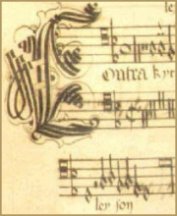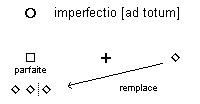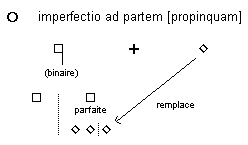| page: Mensuration - the music |
Site
|
Mensuration - the music
|
Mensuration signs
Groups of smaller values Two kinds of dots! Partial imperfection More about alteration Modes and their notation Musical excerpts |
Previous page: The rules |

|
The rhythmical range of most pieces exceeds a single division! That's why I had to wait till now to introduce mensuration signs: all of them specify simultaniously the type of the two very important divisions tempus and prolatio.
Like nowadays, they appear at the beginning of each part to initialize its mensuration, or later on to change it. It wasn't so unfrequent that the various parts of the same piece showed different mensurations.
A modern transcription without reduction of the values would lead to a 9/2 time signature; the modern dot used in this transcription might be confusing, but it's unavoidable in our modern binary-only notation system: here a perfect breve is transcribed to three tied dotted whole notes, a perfect semibreve to a dotted whole note weighting three half notes.
A modern transcription without reduction of the values would lead to a 3/1 time signature: a perfect breve is transcribed to three tied whole notes, each of them weighting two half notes.
A modern transcription without reduction leads to a 6/2 time signature: a perfect semibreve is translated to a dotted whole note.
A modern transcription with no reduction leads to a 2/1 time signature.
I'll honour my promise to drop the N n notation used on the previous page. However we'll still have to write note values: now that we work with two divisions simultaniously, we will take as new unit the smaller note of the prolation, that is the minim.
Therefore, here are, for each mensuration, the note values expressed in terms of this new unit:
| 1 | 1 | 1 | 1 | |
| 3 | 2 | 3 | 2 | |
| 9 | 6 | 6 | 4 |
From now we'll have the great pleasure to hear more sophisticated rythms:
Well, but... what about our rules, expressed up to now in terms of note figures, if we replace these ones by several values of same total weight? Do these rules still apply, and, if they do, how?
Rule G2 : The total value of a group is never modified by an imperfection or an alteration rule.
And these are good news: for, if we had had to split the change of value to every smaller note of the group, the system would have turned to a real nightmare!
example 2bis (to be compared with example 2) :
Thus, as said just above, I1 is not applied to the group of the three first semibreves as a whole!
Rule I4 : A group may cause an imperfection, as might be the case for the note it was replacing.
example 2ter : a)
Here we return to the same evaluation as for the initial example 2: a) the group of two minims is causing imperfection according to rule I1 which overrides I2; b) minim rests act the same way; c) here, values are just halfed (
example 4bis :
The first group of two minims triggers rule I1, the last one rule I2 (see ex 4).
Conversely, when a note or a group does not trigger the application of a rule, then, obviously, it does not either when replaced by smaller values:
example 21 :
The groups wheighting three semibreves do not allow to apply rules I1 or I2, since they already did not when written with semibreve figures, thus: 6 | 2 2 2 | 6 | 2 2 1 1 | 6 | 1 2 2 1 | 6 with a nice small syncope near the end of the sequence!
Working with two different divisons simultaniously, we'll come upon the two sorts of dots; let's summarize about them:

